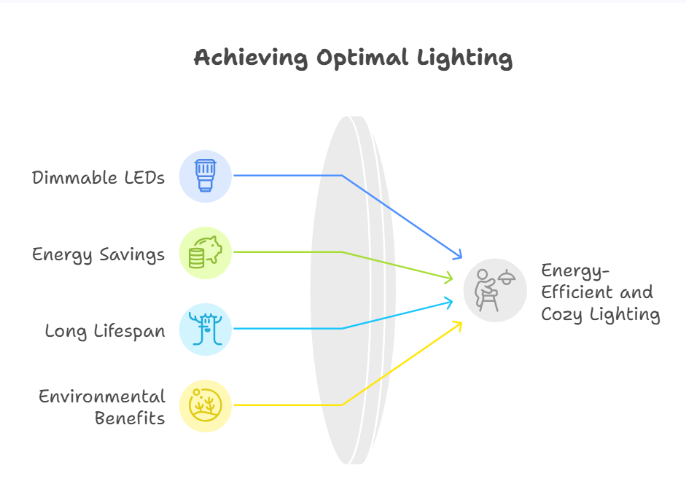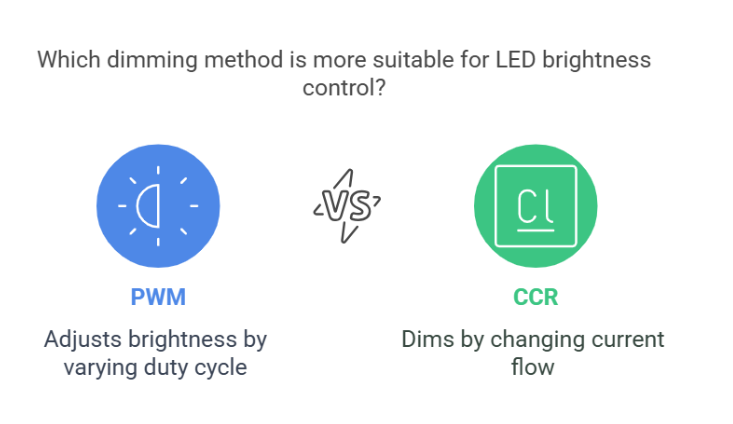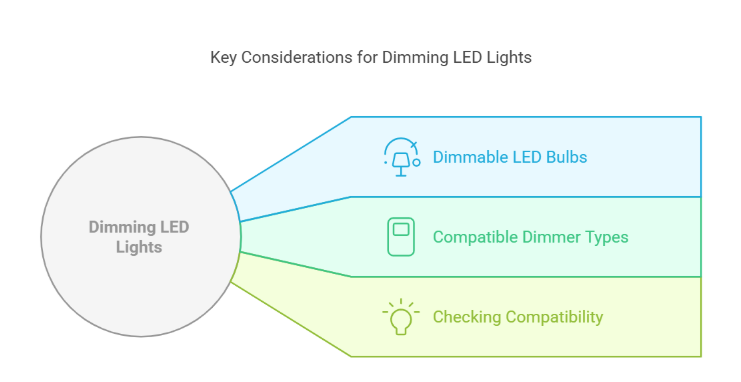A perfect atmosphere starts with the proper illumination. Lighting doesn't just have to be for practicality; there are many ways you can use it for decorative accents too! Dimmed and adjustable lighting options can elevate your interior design and brighten up any room in the house. Introducing a bit of harmonious, dim light can create a warm, cozy ambiance while using less electricity than standard indoor lighting sources. Dimmable lighting gives you the best of both worlds: convenience and savings in one!

LED light sources are one of the most popular lighting choices due to their energy-saving abilities, the longer lifespan of up to 50,000 hours, and sophisticated new fixture options compared to traditional incandescent lamps. Not only do LED lamps emit better light for less wattage, but they also give off virtually no infrared radiation and contain no mercury.
In addition, dimming LEDs save energy up to a remarkable 1:1 ratio; for example, dimming your LED by 50 percent will reduce the associated energy use by a near-equal amount. Considering the vast economic and environmental benefits of using LED lighting, it's easy to see why this type of energy source is favored over other alternatives.
Understanding LED Dimming Techniques and Systems
Dimming LEDs is more than just lowering brightness; it involves working with specialized LED dimming systems or methods to ensure the lights respond correctly. When people talk about LED lighting control, they might be referring to:
- Phase-Cut Dimming (Leading-Edge or Trailing-Edge)
- Smart LED Dimmers (Wi-Fi, Bluetooth, Zigbee, Z-Wave)
- Manual Dimming Alternatives (Resistor-based, PWM, Voltage Control)
- LED Light Switch Dimming (using specific dimmer switches)
- Flicker-free LED Dimming (achieved through compatible drivers and well-matched systems)
In every case, the goal is to achieve smooth LED control, free of flicker or buzzing, while extending the life of the bulbs and potentially reducing energy consumption.
How to Dim LED Lights?
As efficient and versatile as LED lights are, they aren't quite plug-and-play. To customize the brightness of an LED light, a driver must be used in conjunction with it to dim the light. Consumers can easily adjust brightness according to their preferences by using two of the most common methods - Pulse Width Modulation (PWM) and Constant Current Reduction (CCR), also known as Analog Dimming. Together, these two methods make achieving optimal lighting and saving energy easy.
Pulse Width Modulation (PWM)
PWM works by quickly switching the voltage on and off at a variable speed that is too fast for the human eye to detect. The ratio of time when the LED is ON, also called the duty cycle, to the total duration of one complete cycle determines the LED's brightness level in PWM.
This method is especially popular for smooth LED control since well-designed PWM drivers can operate at high frequencies, helping deliver flicker-free LED dimming.
Constant Current Reduction (CCR / Analog Dimming)
CCR is another effective and efficient way to vary the brightness of LED lamps. Unlike PWM dimming, which requires the LED to be regularly switched on and off for varying brightness levels, the LED remains in a constant "on" state in CCR dimming.
Instead of switching the LED on and off, CCR changes the current level that flows through the light. By diminishing this current level, the LED appears to be dimmer. This approach helps maintain a smooth LED control effect without the rapid on-off cycles.

Can You Dim Any LED Light?
When selecting an LED light fixture, the electronic used to power the lighting system determines whether or not the LED bulb is dimmable. Most LEDs require a specially designed dimmer switch for 12V or 230V lights, so it pays to do your research.
If you elect to use a traditional dimmer switch for an LED light, be aware that this could cause problems like buzzing, flashing, or even vibration that can damage the bulbs. It is noted on most LED packages and product descriptions what type of switches are best suited for that particular model.
However, LED dimmer compatibility depends on more than just the bulb; the dimmer itself has to handle the lower wattage and the nature of LED drivers. LED brightness adjustment can be unsuccessful if your dimmer is designed for incandescent bulbs that draw higher power.

Are Your LED Lights Dimmable?
When switching to LED lighting, it's essential to know whether the bulbs you choose are dimmable. It is crucial to ensure that the LED lights are dimmable to avoid risking poor performance and even damaging your bulbs. Many LED products will list right on their packaging whether they are rated for dimming.
Even if your LED light is technically dimmable, the type of dimmer you have could be an issue. Older dimmers were designed for higher-wattage lighting and cannot handle lower-wattage LED bulbs. Before making the switch, it's a good idea to check your bulbs and dimmers to ensure all pieces work properly together. This level of LED lighting control ensures you achieve the energy-efficient LED dimming you're aiming for without flicker or damage.

Why Are Some LEDs Not Able To Dim?
When it comes to dim an LED bulb, the decision depends on what type of LED driver the light uses. You can choose the driver based on your desired dimming options for DIY lighting setups with component LEDs. However, with finished LED fixtures or bulbs from a manufacturer, you are primarily confined to their chosen dimming options.
With non-dimmable drivers, your lights are stuck with only two states: ON and OFF. If you try to change the current to an LED light, the non-dimmable driver will overcompensate to keep things steady and inevitably fail. Choosing an appropriate LED driver is essential for creating an adequate lighting setup that can adjust to your requirements.
Dimmable drivers offer a significant advantage over non-dimmable ones as they are designed to handle drops in current. When the amount of current running through the circuit decreases, dimmable drivers compensate for this change by dimming the LED using either analog or pulse width modulation dimming.
This capability allows for great flexibility regarding the user's control over the brightness and intensity of light produced. It is an ideal choice for theatrical and mood lighting applications requiring a more nuanced level of control, such as LED dimming for home theater installations.

How To Dim LED Lights Without A Dimmer?
Digital lighting has revolutionized the way we illuminate our homes and workplaces. Traditionally, dimmer switches were needed to control the intensity of lights. However, we now have access to various technologies that make it simple and cost-effective to customize lighting according to individual preferences.This approach is referred to as dimming without a dimmer switch.
There are many ways to dim light:
- Smart Bulbs: Purchase LED bulbs with built-in dimming capabilities, controllable via a remote or app. Smart lighting options allow you to dim the lights, change color, and even set timers with your smartphone.
- Plug-In Modules: Devices that sit between your lamp and outlet, offering adjustable brightness (though not always as refined).
- Resistor-Based Hacks: Ideal for small LED projects or strips, but not recommended for entire rooms due to inefficiency.
- Voltage Reduction: Using a lower-voltage power supply can dim the LED, but watch for potential color shift or performance issues.
Recommended Products:
- Smart Bulbs with Wi-Fi or Bluetooth: Quick to set up, no additional wiring needed.
- Remote-Controlled Fixtures: Great for under-cabinet lighting or accent lights.
Dimmer Switches: TRIAC (Leading-Edge), Trailing-Edge, and Compatibility with LEDs
Let's break down specific types of dimmer switches and understand how they interact with LEDs. Two main methods in phase-cut dimming are leading-edge (often called Triac dimming) and trailing-edge dimming.
TRIAC (Leading-Edge) Dimmers
TRIAC stands for Triode for Alternating Current. In leading-edge dimmers, part of the AC waveform is “chopped” at the beginning of each cycle.
1. Pros:
- Common in older homes.
- Generally less expensive since they were originally designed for incandescent lights.
2. Cons:
- May cause buzzing or flicker with some LEDs if not specifically rated for LED loads.
- Can be less smooth in the dimming curve, leading to possible “stepping” in brightness levels rather than smooth LED control.
3. Compatibility:
- Always look for bulbs marked compatible with “leading-edge” or “Triac dimming.”
- Some LED manufacturers list specific TRIAC dimmers that pair best with their products.
Trailing-Edge Dimmers
Trailing-edge dimmers cut the AC waveform at the end of each cycle, resulting in a different kind of phase-cut dimming.
1. Pros:
- Often quieter and produce less electrical noise than leading-edge dimmers.
- Better suited for lower-wattage loads, making them popular for LED applications.
- Provide a flicker-free LED dimming experience more consistently if matched with the right driver.
2. Cons:
- Can be pricier than traditional TRIAC dimmers.
- Might still require checking LED light dimmer compatibility on the packaging or manufacturer's website.
3. Compatibility:
- Usually labeled as “LED-compatible trailing-edge dimmer.”
- Recommended for a wide range of modern LED fixtures because of their smoother control and reduced flicker.
Smart Dimming Solutions: Wi-Fi, Bluetooth, Zigbee, and Z-Wave
Smart LED dimmers are becoming increasingly popular due to their convenience and versatility. These devices often integrate one of the following wireless protocols:
1. Wi-Fi
- Pros: Can connect directly to your home's Wi-Fi network, letting you control lights via a smartphone app or voice assistant.
- Cons: Higher bandwidth use and potential connectivity issues if your network is unstable.
2. Bluetooth
- Pros: Straightforward pairing with phones or tablets; no dedicated hub required.
- Cons: Shorter range; controlling lights from a distance might be problematic if you're out of range.
3. Zigbee
- Pros: Requires a hub (e.g., Philips Hue Bridge) but offers a robust mesh network; can handle multiple devices with minimal congestion.
- Cons: Must invest in a hub or gateway, adding initial cost.
4. Z-Wave
- Pros: Often found in home automation systems, enabling integration with door locks, thermostats, etc.
- Cons: Like Zigbee, needs a hub or controller, and compatibility can vary across brands.
These smart dimming solutions let you schedule lighting changes, use voice commands through platforms like Alexa or Google Assistant, and even track energy usage. They can be combined with touch dimmers in certain designs, providing multiple ways to adjust the lights.
Manual Dimming Alternatives: Resistor-Based, PWM Dimming, and Voltage Control
Sometimes, you may want dimming without a dimmer switch integrated into the wall. Below are some manual dimming alternatives:
Resistor-Based Dimming
- How It Works: A resistor added in series limits the current, lowering brightness.
- Pros: Simple for small-scale DIY projects (e.g., LED strips in hobby applications).
- Cons: Inefficient, as the resistor dissipates the extra energy as heat. Not ideal for standard room lighting.
PWM Dimming
- How It Works: The light is switched on and off rapidly, and adjusting the ratio of on/off time controls brightness.
- Pros: Precise LED brightness adjustment; can be used for complex lighting setups (e.g., stage lighting).
- Cons: Flicker might occur if frequency is not high enough. Must use a driver designed for PWM to maintain flicker-free LED dimming.
Voltage Control
- How It Works: The input voltage is lowered, thus decreasing current flow.
- Pros: Can be used in certain low-voltage LED strip scenarios; straightforward method for small projects.
- Cons: May affect the LED's color temperature and might not be truly “dim-to-off.” Not all LED drivers support partial voltage input.
Comparison Table: Types of Dimmers
|
Dimmer Type |
Pros |
Cons |
Ideal Use Case |
|
Triac (Leading-Edge) |
Widely Available, Less Expensive |
Potential Flicker or Buzzing with LEDs |
Older homes with basic LED needs |
|
Trailing-Edge |
Reduced Noise, Smoother Dimming |
Slightly Higher Cost |
Modern LED installations |
|
Smart (Wi-Fi/Bluetooth/Zigbee/Z-Wave) |
Remote/App Control, Scheduling |
Requires Good Network / Hub |
Tech-savvy households, automation enthusiasts |
|
Resistor-Based |
Simple for DIY Projects |
Inefficient, Heat Dissipation |
Hobby LED strips, small accent lights |
|
PWM Dimming |
Precise Brightness Control |
Risk of Flicker at Lower Frequencies |
Theatrical or specialized lighting |
Dimmable LED Bulbs vs. Non-Dimmable LEDs
Not every LED lamp can reduce brightness by turning a switch. Understanding dimmable LED bulbs vs. non-dimmable LEDs helps prevent issues:
|
Type |
Pros |
Cons |
Examples |
|
Dimmable LED Bulbs |
Specifically designed to work with a range of LED dimmers; label often indicates the types of dimming (TRIAC, trailing-edge, etc.) they support. |
Slightly more expensive than non-dimmable versions. |
Bulbs from major brands often say 'dimmable' on the package, sometimes listing recommended dimmer models or types. |
|
Non-Dimmable LED Bulbs |
Lower initial cost if you don't plan to dim. |
Will flicker or fail if you attempt to dim them. Only ON/OFF states are supported. |
Basic LED bulbs used where no dimming is needed (e.g., closets, garages). |
Always double-check LED light dimmer compatibility to confirm whether your chosen bulbs will work smoothly with your existing or planned dimmer switches. Doing so is key to obtaining energy-efficient LED dimming without flicker or early burnouts.
Flicker Issues & How to Solve Them
LED flicker is one of the most common complaints. Flicker can be subtle or so intense that it bothers the eyes, especially in areas requiring consistent illumination such as offices or home theaters. Below is a rundown of why flicker happens and how to fix it:
Why Do LEDs Flicker When Dimmed?
1. Incompatible Dimmer: Using a dimmer designed for incandescent bulbs with an LED load can lead to flicker.
2. Driver Quality: Some LED drivers can't handle low input or quick changes in voltage and current, causing instability in the light output.
3. PWM Frequency: If the PWM frequency is too low, a noticeable flicker might appear.
Solutions for Flicker-Free LED Dimming
- Choose an LED-Specific Dimmer: Many companies now label their products as “LED-compatible,” reducing the chance of flicker.
- Use High-Quality LED Drivers: Especially important for low-voltage or complex installations.
- Check Load Requirements: Dimmers have minimum and maximum load thresholds. If your total LED wattage is too low or too high, flicker can result.
- Opt for Trailing-Edge Dimmers: Typically provide smoother dimming with modern LEDs.
Step-by-Step Practical Guide
To boost engagement and help you achieve smooth LED control, here are some practical steps for testing dimmability and installing dimmer switches, along with tips for dimming without a dimmer switch.
How to Test If Your LED Is Dimmable
Infographic Concept (Text Description):
1. Examine the Bulb Label: Check for “dimmable” or references to LED dimming techniques.
2. Use a Known LED Dimmer Switch: Temporarily connect your bulb to a tested LED-compatible dimmer.
3. Observe Brightness Changes: If the light dims smoothly without flicker or buzzing, it's likely dimmable.
4. Check the Manufacturer's Info: Visit the brand's website or look for user manuals specifying LED light switch dimming compatibility.
Step-by-Step Guide to Installing a Dimmer Switch
1. Turn Off Power at the Breaker
- Always switch off the circuit before working on electrical fixtures.
2. Remove the Old Switch
- Unscrew the faceplate and gently pull out the existing switch.
- Identify wires (common/hot, load, neutral if present, ground).
Choose the Right Dimmer
- Pick a dimmer rated for your LED load, ensuring LED dimmer compatibility.
- Look for “Triac dimming” or “trailing-edge” if your bulbs specify those methods.
Connect Wires to the New Dimmer
- Follow the manufacturer's instructions. Usually, line to line, load to the fixture, ground to ground, and neutral if required.
Mount and Test
- Secure the dimmer in place, restore power, and gradually adjust brightness.
- Check for flicker, buzzing, or any signs of instability.
Real-World Use Cases & Examples
Home Theaters: Importance of Smooth Dimming
LED dimming for home theater environments ensures you can transition from bright, functional lighting to soft, cinematic shadows. A trailing-edge dimmer or a well-designed smart LED dimmer typically works best here. Smooth LED control helps avoid distraction during movies, and the ability to dim to very low levels can replicate a theater-like experience.
Bedrooms & Living Spaces: Creating Warm Lighting
Dimming LED lights in living rooms and bedrooms can foster a calm atmosphere for reading, watching TV, or simply relaxing. Many people invest in touch dimmers on bedside lamps so they don't have to fumble for switches. Alternatively, a smart LED dimmer connected to a voice assistant can control overhead lights with simple commands.
Commercial Spaces: Offices, Restaurants, and Retail Stores
In corporate or commercial settings, energy-efficient LED dimming can significantly cut overhead costs. Offices often require bright lighting for productivity, but they may reduce brightness for presentations or after-hours. Restaurants and retail stores may prefer low, warm lighting during evening hours for the atmosphere. This strategy saves energy and extends the life of the fixtures through wattage control for LEDs.
Expert Opinions & Technical Insights
Electrical engineers and lighting experts often emphasize the following:
1. Voltage Drop & Current Control:
- Insight: The science of LED dimming is about balancing voltage, current, and the LED driver's capacity. A mismatch can shorten bulb life or cause flicker.
- Professional Tip: Always size dimmers for a bit more wattage than your actual LED load to ensure stable LED brightness adjustment.
2. Manufacturer Recommendations for the Best Dimmers:
- Insight: Many LED bulb manufacturers publish lists of compatible dimmers. Checking these lists can save you from flickering or humming noises.
- Example: Philips, GE, and other big brands often have “LED compatibility charts” on their websites.
Science of Dimming (PWM vs. Analog):
- Insight: PWM is a digital form of dimming, toggling the light rapidly, while analog (CCR) reduces current. Both can provide energy-efficient LED dimming if executed properly.
- Professional Tip: For a truly flicker-free LED dimming experience, ensure PWM is set to a high frequency—generally above 2 kHz—so the human eye can't detect the flicker.
Final Thought
Dimming LED lights offer both convenience and saves energy while improving the visual appeal of your space. By selecting the proper LED dimming techniques—whether Triac dimming, trailing-edge dimming, or smart LED dimmers—you can avoid flicker, maintain smooth LED control, and extend the lifespan of your bulbs.
Always remember to check LED light dimmer compatibility, consider wattage control for LEDs, and pick solutions that align with your environment—be it LED dimming for home theater, cozy living room setups, or commercial spaces seeking energy-efficient LED dimming.
If you are looking for high-quality dimmable lights that will allow you to shape your interior atmosphere and save energy, Buy LED Online is the perfect place to shop. We have a broad variety of LED lighting and fixtures available at competitive prices and a team to offer the best customer service.
Frequently Asked Questions:
1. Can you dim LED lights without a dimmer switch?
Yes, you can dim LED lights without a traditional dimmer switch by using alternative methods such as lowering voltage, using smart bulbs, or adding resistors. Some LED bulbs also have built-in dimming features.
2. What is the easiest way to dim LED lights without a dimmer?
The easiest way is to use smart LED bulbs or plug-in dimmers, which allow you to control brightness via a remote or mobile app. If you prefer a manual solution, using a lower-voltage power supply can help reduce brightness.
3. Can I use a resistor to dim LED lights?
Yes, adding a resistor in series with the LED can reduce brightness. However, this method requires basic electrical knowledge and may not work efficiently for all LED types.
4. Will reducing the power supply dim LED lights?
Yes, lowering the voltage can reduce brightness, but it may also affect the performance of the LED. It’s best to check the LED’s voltage range before attempting this method.
5. Do smart plugs or smart bulbs help in dimming LEDs?
Yes, smart plugs with dimming functions and smart bulbs that connect to apps allow you to control brightness without a traditional dimmer switch. These are great alternatives for those who want easy, adjustable lighting.
6. Can covering the LED with a filter or film reduce brightness?
Yes, using frosted covers, diffusers, or window tint film can soften and reduce the brightness of LED lights. This is a non-technical and cost-effective method.
7. Why do some LEDs flicker when dimmed without a proper dimmer?
LEDs may flicker due to incompatible dimming methods, improper power supply regulation, or low-quality LED drivers. If flickering occurs, using a compatible LED driver or smart dimming device can help.
8. Are there any safety concerns when dimming LEDs without a dimmer?
As long as you use safe methods like smart bulbs, resistors, or voltage reduction, there are no major safety risks. However, improper wiring or using resistors incorrectly could lead to overheating or electrical issues.
9. Do all LED bulbs support dimming?
No, only dimmable LED bulbs are designed to work with dimming methods. If your bulb is not labeled as "dimmable," alternative methods like smart controls or diffusers may be more effective.
10. Where can I buy the best dimmable LED solutions?
You can find dimmable LED bulbs, smart lighting solutions, and diffusers on Buy LED Online, Amazon, Home Depot, and other lighting retailers.
Check out Our Products:
Residential LED Lighting Fixtures
Office/Commercial LED Lighting Fixtures
LED Recessed Downlight Lighting
Check out other articles:
The Complete Guide to Recessed Lighting and How it Can Transform Your Home
How To Install A Dimmer Light Switch?





